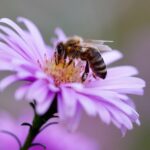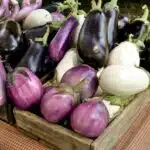Aster yellows is a plant disease that causes significant economic losses in various crops worldwide. This phytoplasma disease affects plants’ growth and development, leading to stunted growth, yellowing of leaves, and malformed flowers. As a plant pathologist, it is crucial to understand the symptoms, treatments, and prevention measures for aster yellows to mitigate its impact on crops.
Identification of aster yellows can be challenging since its symptoms can resemble those caused by other plant diseases or environmental stressors. However, as a plant pathologist, one should be able to differentiate the symptoms based on their severity and pattern of occurrence. Once identified, aster yellows can be treated through cultural practices such as removing infected plants or using insecticides to control the spread of the disease. Prevention measures include practicing good hygiene by sterilizing tools and avoiding planting susceptible crops near infected plants. This article will delve into more details on how to identify, treat, and prevent aster yellows in various crops.
Understanding Aster Yellows And Its Impact On Crops
Lush fields of vibrant crops are a sight to behold. They represent the result of hard work and dedication by farmers. Unfortunately, these fields are not always immune to the tiny pathogens that wreak havoc on plants. Among these pathogens is aster yellows, a plant disease caused by phytoplasma transmission.
Aster yellows has significant economic impact due to its ability to infect over 300 species of plants, making it a threat to both ornamental and agricultural crops. Common hosts include lettuce, carrot, onion, potato, tomato, and grapevine. The disease can reduce crop yield and quality, leading to significant financial losses for farmers.
Phytoplasma transmission occurs through feeding activities of aphids and leafhoppers that transmit the bacteria-like organism from infected plants to healthy ones. Once inside the plant’s phloem tissue, aster yellows disrupts normal development processes by altering the hormonal balance in the host plant. The symptomatology varies depending on the plant species but commonly includes yellowing of leaves and stunted growth.
Overview Of Phytoplasma Diseases
Aster yellows is a plant disease caused by phytoplasma, which is a type of plant pathogen that affects the reproductive systems of plants. This disease can be identified through its characteristic symptoms, such as stunted growth, yellowing of leaves, and abnormal development of flowers. The impact of aster yellows on crops can be devastating as it reduces yield and quality.
Effective management techniques can be employed to prevent the spread and severity of aster yellows. One way to manage this disease is through cultural practices like crop rotation and removal of infected plant debris. Additionally, the use of insecticides can help control the spread of the insects that transmit aster yellows. However, there are no known chemical treatments for the disease itself.
Prevention is key in managing aster yellows. Early detection and removal of infected plants are crucial in preventing further spread to healthy plants. It is also important to monitor crops regularly for signs and symptoms of infection to catch any outbreaks early on. By implementing these strategies, growers can reduce the impact of aster yellows on their crops and increase overall yield and quality.
Moving forward, it is essential to understand the symptoms of aster yellows in plants to effectively manage this disease. Some common symptoms include yellowing or purpling of leaves, stunted growth, distorted flowers or buds, leaf-like growths on flower parts, and reduced yield or fruit quality. These symptoms may vary depending on the affected plant species but are generally indicative of phytoplasma infection. By recognizing these symptoms early on and taking appropriate action, growers can prevent further spread and minimize negative impacts on crop production.
Symptoms Of Aster Yellows In Plants
As a plant pathologist, I have witnessed the devastating effects of Aster Yellows on plants. This disease is caused by the phytoplasma bacterium and can affect over 300 species of plants, including vegetables, flowers, and trees. It is spread by leafhoppers, which are tiny insects that feed on the sap of plants.
The symptoms of Aster Yellows in plants can be challenging to identify initially. However, it is crucial to recognize them early to prevent further plant damage. One of the most common symptoms is yellowing and twisting of leaves. The leaves may also become elongated or stunted. In addition to this, you may notice an excessive amount of shoots developing from one point on the plant. Flowers may also appear deformed or discolored.
Prevention strategies are essential for controlling Aster Yellows as there is no cure once a plant has been infected. Implementing integrated pest management techniques such as regular monitoring for leafhoppers and removing any infected plants can help prevent the disease from spreading further. Additionally, avoid planting susceptible crops in areas where Aster Yellows has been previously identified. By taking these preventative measures, we can reduce the occurrence and impact of this destructive disease on our plants.
Moving forward, it’s vital to differentiate aster yellows from other plant diseases accurately. Understanding how it differs from other bacterial diseases like blight and wilt is crucial for effective diagnosis and treatment. In the next section, we will explore how to distinguish Aster Yellows from other plant diseases using specific characteristics and symptoms unique to each ailment.
Differentiating Aster Yellows From Other Plant Diseases
Aster yellows is characterized by symptoms such as yellowing leaves, deformed flowers and stunted growth. It is caused by a phytoplasma, a bacteria-like organism, that is transmitted through leafhoppers. Controlling the spread of leafhoppers with insecticides is an effective treatment, as well as crop rotation and sanitation. To prevent aster yellows, it is important to differentiate it from other plant diseases such as bacterial blight, fungal diseases, viral infections, and insect damage. Identifying the disease can be done by comparing the symptoms to other plant diseases and controlling abiotic factors like plant nutrition. With proper identification and preventive measures, it is possible to limit the spread and damage of aster yellows.
Symptoms
Aster yellows is a phytoplasma disease that can infect over 300 plant species, including vegetables, fruits, and ornamental plants. It is caused by the bacterium-like organism called phytoplasma, which is transmitted to plants through leafhoppers. The symptoms of aster yellows can be easily confused with those of other plant diseases such as herbicide damage or nutrient deficiencies.
The progression of aster yellows disease starts with the infection of the plant’s phloem tissue, which transports nutrients and sugars throughout the plant. As the bacteria multiply in the phloem tissue, they clog up the transport system and disrupt nutrient flow within the plant. This leads to a range of symptoms that include stunted growth, yellowing or purpling of leaves, proliferation of small shoots or flowers, and abnormal development of floral parts. In some cases, infected plants may not produce flowers or fruits at all.
To differentiate aster yellows from other diseases, it is important to observe the unique symptoms associated with this disease. One key symptom that distinguishes aster yellows from other diseases is the presence of witches’ brooms – clusters of stunted stems or branches growing from a single point on a plant. Additionally, aster yellows often causes distorted leaf veins that appear twisted or curled around the edges of leaves. By familiarizing oneself with these distinct symptoms and understanding the causes and progression of aster yellows disease, one can accurately identify and manage this bacterial infection in their plants for healthy growth and production.
Causes
As plant pathologists, it is crucial to differentiate aster yellows from other plant diseases due to its ability to infect over 300 plant species, including vegetables, fruits, and ornamental plants. To accurately identify and manage this bacterial infection in plants, one must understand the causes of aster yellows. The transmission methods of this disease are through leafhoppers, which act as vectors for the bacterium-like organism called phytoplasma.
Environmental factors also play a role in the development and progression of aster yellows. High temperatures and drought stress can increase the severity of infection, leading to more pronounced symptoms. Furthermore, infected seeds and transplants can also introduce the disease into new areas or crops. However, it is important to note that not all plants are susceptible to aster yellows; some have natural resistance or tolerance to the disease.
In conclusion, understanding the causes of aster yellows is crucial for accurate identification and management of this bacterial infection in plants. By knowing the transmission methods through leafhoppers and recognizing environmental factors that contribute to disease severity, plant pathologists can help prevent further spread of this disease while serving others in the agriculture industry.
Treatment
As mentioned earlier, aster yellows is a bacterial infection that affects a wide range of plant species. Once identified, it is crucial to apply the appropriate treatment to prevent further spread and minimize damage. However, considering the complex nature of this disease, plant pathologists must explore different treatment options available.
One approach to managing aster yellows is by enhancing plant immunity. This can be achieved through the application of natural products such as seaweed extracts or essential oils. These substances contain compounds that stimulate plant defense mechanisms, making them less susceptible to infections. Additionally, introducing beneficial microorganisms into the soil can help improve plant health and resistance to diseases.
Another method that can be used to control aster yellows is microbial control. This involves the use of biological agents such as bacteria or fungi that are antagonistic against the phytoplasma causing aster yellows. These agents can colonize plants and protect them from infection or reduce disease severity when applied at early stages of infection.
In summary, treating aster yellows requires a comprehensive understanding of its causes and symptoms. Plant pathologists have various options available for managing this disease, including enhancing plant immunity and microbial control. By utilizing these strategies in combination with other best practices, they can effectively control the spread of aster yellows while promoting healthy crop growth and yield.
How To Conduct A Plant Disease Diagnosis
Plant disease diagnosis is a crucial aspect of maintaining plant health and preventing the spread of diseases. Identifying symptoms of plant diseases is the first step in determining the appropriate management strategy. Symptoms can include wilting, yellowing, necrosis, stunting, and abnormal growth patterns. In addition to visual symptoms, other diagnostic techniques may include culturing, serological tests, and molecular assays.
When conducting a plant disease diagnosis, it is important to consider environmental factors such as temperature and moisture levels. Plant pathogens thrive under specific conditions and understanding these conditions can aid in identifying potential diseases. It is also important to consider the history of the plant including any recent changes to soil or planting location.
To assist in identifying symptoms accurately, it may be helpful to create a nested bullet point list with two sub-lists:
- Visual Symptoms:
- Wilting
- Yellowing
- Necrosis
- Stunting
- Abnormal growth patterns
- Diagnostic Techniques:
- Culturing
- Serological tests
- Molecular assays
In conclusion, proper identification of symptoms is essential for effective plant disease diagnosis. Environmental factors and plant history should also be considered when determining potential diseases. Utilizing diagnostic techniques such as culturing or molecular assays can assist in accurate identification of plant pathogens. The next step in managing plant diseases is treatment options for aster yellows which will be discussed further in the subsequent section.
Treatment Options For Aster Yellows
Aster Yellows is a viral disease caused by a mycoplasma-like organism that affects a wide variety of plants. Chemical interventions can be employed to control the spread of this disease, including the application of insecticides to reduce vector populations and foliar treatments of fungicides to prevent infection. Biological control methods, such as the introduction of predatory insects, may also be effective in reducing the spread of the disease. Crop rotation can be used to prevent infection as well; by planting resistant species or rotating out of affected crops, the risk of infection can be minimized. Further research is needed to determine the most effective methods of controlling and preventing Aster Yellows.
Chemical Interventions
In the search for effective treatments against Aster Yellows, plant pathologists have explored chemical alternatives to control vector populations. Chemical interventions include the use of insecticides, which are chemicals designed to kill or repel insects and other arthropods. These products may be applied as sprays or soil drenches. Some insecticides used against Aster Yellows vectors in the past include acephate, imidacloprid, and spinosad. However, the efficacy of these products varies depending on environmental factors such as temperature and rainfall.
While chemical interventions can be effective against Aster Yellows vectors, their use should be carefully considered due to potential environmental impact. Insecticides can harm non-target organisms and disrupt natural ecosystems. Furthermore, overuse of insecticides can lead to resistance in vector populations, rendering them ineffective in controlling outbreaks. Therefore, plant pathologists suggest that chemical interventions should be used in combination with other management practices such as crop rotation and biological controls.
In conclusion, while chemical alternatives exist for controlling Aster Yellows vectors, their use should be approached with caution due to potential environmental impacts and risk of resistance development. Plant pathologists recommend integrated pest management strategies that incorporate a range of approaches to manage outbreaks effectively while minimizing negative effects on the environment. Ultimately, it is vital to continue exploring new research avenues to identify more sustainable treatment options for Aster Yellows that balance effectiveness with environmental protection.
Biological Control
Biological control is another potential treatment option for managing Aster Yellows outbreaks. This approach involves using natural enemies of the vector species to limit their populations and reduce the spread of the disease. Biological control has several advantages over chemical interventions as it does not harm non-target organisms or disrupt ecosystems. Furthermore, it can be a more sustainable solution as natural enemies can adapt to changing environmental conditions and may not lead to resistance development in vector populations.
Despite its potential benefits, biological control also presents several implementation challenges. One significant challenge is identifying and introducing suitable natural enemies that are effective against vector species without causing harm to other organisms. Additionally, the success of biological control is dependent on various environmental factors such as temperature, humidity, and host plant availability, which can limit its effectiveness. Therefore, plant pathologists must carefully consider these factors when implementing biological control strategies for Aster Yellows management.
In conclusion, biological control presents a promising treatment option for managing Aster Yellows outbreaks while minimizing negative impacts on the environment. However, successful implementation requires careful consideration of several factors such as identifying suitable natural enemies and understanding environmental limitations. As research continues to explore new avenues for sustainable pest management practices, incorporating biological control into integrated pest management strategies can help mitigate the impact of Aster Yellows on crops and ecosystems.
Crop Rotations
Another potential treatment option for managing Aster Yellows outbreaks is through crop rotations. Crop rotations involve alternating the types of crops grown in a particular field or area to disrupt the life cycle of the vector species and reduce disease spread. This approach can also improve soil health and reduce the need for chemical interventions. Companion planting, which involves planting different crop species together to enhance their growth, can also be incorporated into crop rotation strategies for added benefits.
Implementing crop rotations as a treatment option for Aster Yellows management presents several advantages. Firstly, it allows for continuous production without relying on chemical interventions that may harm non-target organisms or cause environmental damage. Secondly, it promotes soil health by reducing nutrient depletion and enhancing fertility, leading to improved plant growth and reduced susceptibility to diseases like Aster Yellows. Additionally, incorporating companion planting into crop rotation strategies can further enhance soil health and pest management.
However, implementing effective crop rotations requires careful consideration of several factors such as crop compatibility and pest pressure in specific areas. Furthermore, some crops may be more susceptible to Aster Yellows than others, making it crucial to choose resistant varieties when planning crop rotations. Despite these challenges, incorporating crop rotations into integrated pest management strategies can provide an effective long-term solution for managing Aster Yellows outbreaks while promoting sustainable agricultural practices.
Cultural Practices For Managing Aster Yellows
After exploring the various treatment options for aster yellows, it is important to consider cultural practices that can aid in preventing the spread of this disease. The use of cover crops has been noted as an effective method of reducing the incidence of aster yellows. Cover crops such as rye and clover help to improve soil health by increasing organic matter content, which can reduce the occurrence of pests and diseases.
In addition to cover crops, proper soil management is also crucial in preventing aster yellows. Soil should be tested regularly to ensure proper nutrient balance and pH levels. Maintaining healthy soil can promote plant vigor and resilience against diseases like aster yellows. It is also important to rotate crops, as this can prevent the buildup of pathogens in the soil over time.
By implementing these cultural practices, growers can take proactive steps towards preventing the onset of aster yellows in their crops. While these methods may not completely eliminate the risk of infection, they can help to reduce its impact on crop yield and quality. In the next section, we will explore another option for controlling aster yellows: using insecticides.
Transitioning into our next topic about using insecticides to control aster yellows, it is important to note that chemical control methods are often used in conjunction with cultural practices for optimal results. When considering insecticide use for managing aster yellows, it is important to first identify which species are present in order to select an appropriate product. Insecticides such as neonicotinoids or pyrethroids may be effective against certain species of leafhoppers that transmit aster yellows. However, it is important to carefully follow label instructions and avoid overuse or misuse of these products to prevent negative impacts on beneficial insects or other non-target organisms.
Using Insecticides To Control Aster Yellows
When choosing an insecticide to control Aster Yellows, plant pathologists must consider the type of plant, the severity of the disease, and environmental conditions. To apply insecticides effectively, plant pathologists must adhere to the product label instructions, take precautions to avoid contamination of nearby plants, and use personal protective equipment. Additionally, plant pathologists should choose insecticides that are formulated to target the specific insect vectors that are known to transmit Aster Yellows. Lastly, to help prevent the spread of Aster Yellows, planting resistant varieties and crop rotations are also recommended.
Choosing An Insecticide
When it comes to controlling aster yellows, selecting the right insecticide is crucial. The first step in choosing an insecticide is to identify the type of insects that are causing the problem. This can be done through monitoring and sampling plant tissue for signs of infection. Once identified, a range of insecticides can be considered based on their efficacy and potential harm to non-target organisms.
Insecticide selection requires careful consideration of several factors such as target pest, application method, and residual activity. Insecticides that have been specifically tested for efficacy against aster yellows should be prioritized. It is also important to consider the environmental impact of each insecticide before making a final decision. For example, some insecticides may have negative effects on beneficial insects or contaminate nearby water sources.
Efficacy testing is essential when selecting an insecticide for controlling aster yellows. Insecticides should be tested under conditions that are similar to those in which they will be used in the field. This will help ensure that the selected product will effectively control the targeted pests while minimizing any negative impacts on other organisms or the environment. By taking these steps, growers can effectively manage aster yellows while minimizing risks to human health and the environment.
Applying Insecticides Effectively
Effective application of insecticides is crucial in controlling aster yellows. There are different types of insecticides available, and selecting the right one depends on the target pest, application method, and residual activity. Insecticides can be applied through foliar sprays, soil drenches, or injection into trunks or stems. The choice of application technique will depend on several factors such as plant size, growth stage, and targeted pests.
The efficacy of insecticides is greatly influenced by their proper application. It is important to apply insecticides when the targeted pests are most susceptible and when weather conditions are optimal for their effectiveness. In addition, thorough coverage of the plant tissue is essential for effective control of aster yellows. This can be achieved by using appropriate equipment that ensures uniform distribution of the insecticide throughout the canopy.
Proper handling and storage of insecticides are also critical for effective control of aster yellows. Chemicals should be stored in a secure location away from children and pets. Pesticide applicators should wear protective clothing to avoid exposure to harmful chemicals during handling and application. Proper disposal of excess pesticides or containers is necessary to prevent contamination of soil or water sources. By adhering to these guidelines, growers can successfully apply insecticides for effective control of aster yellows while minimizing risks to human health and the environment.
Timing And Application Of Insecticides
To illustrate the importance of timing and application of insecticides, let us consider the case of a potato farmer who noticed an increase in aster yellows incidence in his field. Despite using insecticides, the disease continued to spread, leading to significant crop losses. Upon investigation, it was discovered that the insecticide used was not effective against the vector responsible for transmitting aster yellows.
Insecticide selection is critical in controlling aster yellows. Not all insecticides are created equal, and selecting one that targets the specific vector responsible for spreading the disease is crucial. Before applying any insecticide, it is important to identify the vector species present in the field and choose a product that is effective against them. Conducting regular efficacy tests can also help track effectiveness and determine if any changes need to be made before significant damage occurs.
Timing plays a vital role in ensuring successful control of aster yellows. Application should occur during periods when vectors are most active, such as early morning or late afternoon when temperatures are cooler, and humidity is higher. Apply insecticides before plants reach peak flowering to prevent damage from infected insects. It is also essential to follow label instructions carefully when applying pesticides to avoid overuse or underuse.
Moving on from timing and application of insecticides, prevention measures for aster yellows should include cultural practices like crop rotation and introducing resistant varieties into the production system. These practices can reduce plant susceptibility to infection while maintaining soil health and fertility levels conducive to plant growth. In addition, monitoring fields regularly for signs of infection can help detect problems early enough before they become severe or widespread. Overall, taking preventative measures alongside proper pest management strategies can help ensure a healthy crop yield year after year.
Prevention Measures For Aster Yellows
Prevention measures for aster yellows are crucial in managing the spread of the disease. Natural remedies can be a great way to prevent and avoid the use of harmful chemicals. One natural remedy is to keep the soil healthy by using compost or other organic matter, which promotes plant growth and enhances their immune system against diseases. This helps to reduce stress on plants, making them less susceptible to infections such as aster yellows.
Another effective way to prevent aster yellows is through chemical control. Insecticides can be applied to protect plants from insect vectors that transmit aster yellows phytoplasma. It is important to note that insecticides should be used in a responsible manner, following label directions and application rates. Overuse or misuse of insecticides can lead to environmental pollution and harm non-target organisms, including beneficial insects.
In conclusion, prevention measures are key in controlling aster yellows disease. Natural remedies such as improving soil health and using compost can help boost plant immunity while chemicals such as insecticides can be used for effective control of vectors. Plant pathologists recommend farmers and gardeners use these prevention measures appropriately to ensure sustainable management of aster yellows disease. The next section will discuss hygiene practices for preventing aster yellows disease spread in more detail.
Hygiene Practices For Preventing Aster Yellows
As we have discussed in the previous section, preventing aster yellows is crucial to maintaining the health of your crops. However, prevention can only go so far, and sometimes identification and treatment are necessary. In this section, we will discuss sanitation practices that can help prevent the spread of aster yellows and handwashing techniques that can reduce contamination.
Sanitization practices are essential to controlling the spread of aster yellows. It is recommended that growers clean all equipment, tools, and surfaces regularly with a dilute bleach solution or other sanitizing agent. This includes anything that comes into contact with plants or soil, such as buckets, trays, and even gloves. Additionally, any infected plant material should be removed immediately and disposed of properly to avoid further spread.
Another critical aspect of preventing aster yellows is proper handwashing techniques. Hands can easily become contaminated when handling infected plants or equipment that has come into contact with them. To reduce the risk of spreading disease through human contact, growers should wash their hands frequently with soap and water for at least 20 seconds before handling plants or other materials.
In conclusion, proper sanitation practices and handwashing techniques are essential to preventing the spread of aster yellows. By taking these steps to reduce contamination from equipment and humans alike, growers can significantly reduce the risk of infection within their crops. In the subsequent section about crop rotation and companion planting, we will explore additional measures for controlling diseases like aster yellows in a sustainable manner.
Crop Rotation And Companion Planting
Crop rotation has numerous benefits, including reducing pest and disease pressure, improving soil health, and reducing the need for synthetic fertilizers and pesticides. Plant selection for companion planting should be based on the benefits that each species provides to the other, such as attracting beneficial insects, deterring pests, and improving soil fertility. Plant spacing for companion planting is important for ensuring that the plants are situated in a way that maximizes their effects on one another, such as providing shade to shade-loving plants. The practice of crop rotation and companion planting can also help to manage aster yellows by reducing the likelihood of an infestation and preventing further spread of the disease. Understanding the benefits of crop rotation and companion planting, as well as the proper plant selection and spacing, is key to effectively managing the spread of aster yellows.
Benefits Of Crop Rotation
Crop rotation is a crucial practice in agriculture that offers several benefits to farmers. One of the significant advantages of crop rotation is crop diversity, which enhances soil fertility and reduces pest pressure. Crop diversity presents an excellent opportunity for farmers to improve soil health by planting different crops each season. The variety of plants helps to replenish the soil with essential nutrients, thus reducing dependence on synthetic fertilizers.
Crop rotation also minimizes soil-borne diseases that can devastate crops and reduce yields. The practice ensures that pathogens and pests are interrupted in their life cycle, thereby reducing their populations. For instance, planting legumes such as beans or peas in one season and brassicas like broccoli or cabbage in another season can help break the life cycle of nematodes, which are known to cause root rot disease in plants.
In conclusion, crop rotation has significant benefits for both the farmer and the environment. It increases soil fertility, reduces pest pressure, minimizes soil-borne diseases, and improves overall plant health. By incorporating crop rotation into their farming practices, farmers can maintain a healthy ecosystem while increasing their yield and profits. Therefore, it is advisable for farmers to adopt this practice continually.
Plant Selection For Companion Planting
Crop rotation is an essential practice in agriculture that helps to maintain soil health and increase crop yields. Another crucial aspect of sustainable farming is companion planting, which involves growing different crops together to enhance their growth and productivity. Companion planting offers several benefits, such as improving soil fertility, reducing pest pressure, and maximizing space utilization. However, the success of this practice largely depends on proper plant selection strategies.
Plant selection for companion planting requires careful consideration of plant characteristics such as growth habits, nutrient requirements, and pest susceptibility. Farmers must choose plants that complement each other’s needs and provide mutual benefits. For example, planting beans alongside corn can improve soil fertility by fixing nitrogen in the soil while corn provides support for the beans to climb. Similarly, planting marigolds or other aromatic herbs next to vegetables like tomatoes or peppers can repel pests naturally and reduce the need for chemical pesticides.
Overall, selecting the right plants for companion planting is crucial to achieving maximum benefits from this practice. By choosing complementary plants that work well together and provide mutual benefits, farmers can improve overall crop health and productivity while reducing their environmental impact. As a plant pathologist, I recommend farmers take time to research and plan their companion planting strategy carefully to ensure they get the most out of this sustainable farming practice.
Plant Spacing For Companion Planting
Crop rotation and companion planting are essential practices in sustainable agriculture that aim to maintain soil health, reduce pest pressure, and improve crop yields. One crucial aspect of companion planting is proper plant spacing. Farmers must consider the growth habits of plants when selecting their spacing strategy to ensure they get the most out of this practice.
Proper plant spacing for companion planting offers several benefits. It allows each plant to receive enough sunlight, water, and nutrients, which can enhance their growth and productivity. Additionally, adequate spacing between plants can allow for better airflow, reducing the risk of diseases such as powdery mildew or fungal infections. By providing each plant with optimal growing conditions, farmers can maximize space utilization while improving overall crop health.
However, it’s essential to note that different plants require different spacing strategies. Some plants like tomatoes or peppers may need more space between them than others like lettuce or radishes. Farmers must research and plan their plant spacing carefully to ensure they provide enough room for each plant while still maximizing space utilization. Overall, proper plant spacing for companion planting is crucial in achieving maximum benefits from this practice. By providing each plant with optimal growing conditions and maximizing space utilization, farmers can improve overall crop health while reducing their environmental impact.
Planting Resistant Varieties
Planting resistant varieties is an effective strategy to prevent and manage aster yellows in crops. This approach involves the use of disease-resistant breeding techniques to develop plant varieties that have a natural resistance to the disease. By planting these varieties, farmers can reduce the risk of infection and minimize yield losses.
Crop selection and management techniques also play an important role in preventing aster yellows. Farmers should choose crops that are less susceptible to the disease, such as those with shorter growing seasons or those that flower earlier. Additionally, proper crop management practices, such as crop rotation and weed control, can help reduce the incidence of aster yellows.
Pest management strategies are also crucial in preventing and managing aster yellows. Insecticides can be used to control the leafhopper vectors that transmit the disease from one plant to another. However, it is important to note that indiscriminate use of insecticides can harm beneficial insects and pollinators. Therefore, farmers should adopt integrated pest management strategies that incorporate both chemical and non-chemical methods for pest control.
By adopting disease-resistant breeding techniques, crop selection and management practices, as well as integrated pest management strategies, farmers can effectively prevent and manage aster yellows in their crops. The next step is monitoring and early detection of this disease, which will be discussed in detail in the subsequent section.
Monitoring And Early Detection Of Aster Yellows
Like planting resistant varieties, identifying and treating aster yellows is crucial in preventing its spread. However, early warning is still the best way to control the disease. Early detection of aster yellows requires field scouting and knowledge of its symptoms.
Field scouting involves regularly inspecting plants for signs of infection. Symptoms of aster yellows include yellowing and stunting of leaves, as well as greenish-yellow discoloration of flower parts. Infected plants may also produce malformed or abnormal flowers. Early detection can prevent the spread of the disease to other plants.
In addition to monitoring and early detection, prevention is key to managing aster yellows. Removing infected plants from the area helps reduce the risk of infecting healthy plants. Insecticides may also be used to control the spread of aster yellows by killing leafhoppers that transmit the disease. By implementing these strategies, plant pathologists can effectively manage aster yellows and protect crops from damage caused by this devastating disease.
Transition: While identifying, treating, and preventing aster yellows are important steps in managing this plant disease, there are still areas for improvement in research that could help further minimize its impact on agriculture.
Conclusion And Future Directions For Research
Future research directions for aster yellows should focus on developing more efficient and cost-effective diagnostic tools. PCR-based techniques for the detection of the phytoplasma responsible for aster yellows have been developed, but they are still considered expensive and time-consuming. A more practical approach would be to develop a rapid test that can be performed in the field, allowing prompt diagnosis and treatment.
Another area of interest is the development of novel treatment approaches that can effectively manage aster yellows infections. Currently, there are no chemical treatments available that can cure infected plants; therefore, non-chemical alternatives should be explored. One promising approach is the use of biological control agents such as plant growth-promoting rhizobacteria (PGPR) which have been shown to enhance plant resistance to various diseases.
In conclusion, aster yellows remains a significant challenge for plant pathologists and growers alike due to its elusive nature and lack of effective treatments. Future research should focus on developing rapid diagnostic tools and exploring alternative treatment options such as PGPRs. By doing so, we may be able to prevent widespread outbreaks and provide better solutions for those affected by this debilitating disease.
Conclusion
Aster yellows is a phytoplasma disease that affects over 300 plant species, including crops such as lettuce, carrots, and onions. The disease is caused by the bacterium-like organism known as phytoplasma, which invades the phloem tissue of plants and disrupts their growth and development. Symptoms of aster yellows include yellowing and stunting of leaves, abnormal flower formation, and the presence of greenish-brown nodules on plant tissue.
As a plant pathologist, it is essential to differentiate aster yellows from other plant diseases using diagnostic techniques such as microscopy, PCR testing, and serological assays. Crop rotation and companion planting are effective strategies for preventing the spread of aster yellows in fields. Additionally, planting resistant varieties can reduce the impact of the disease on crops.
Monitoring and early detection are crucial to managing aster yellows outbreaks successfully. According to recent statistics, over 80% of growers in North America have reported an increase in phytoplasma diseases like aster yellows in recent years. Future research should focus on developing more effective methods for identifying and managing this disease while promoting sustainable agricultural practices that minimize its impact on crop yields. With these measures in place, we can ensure healthy harvests while safeguarding our environment for generations to come.
Image Credits
- “Early goldenrod (Solidago gigantea)” by Evelyn Simak (featured)





























